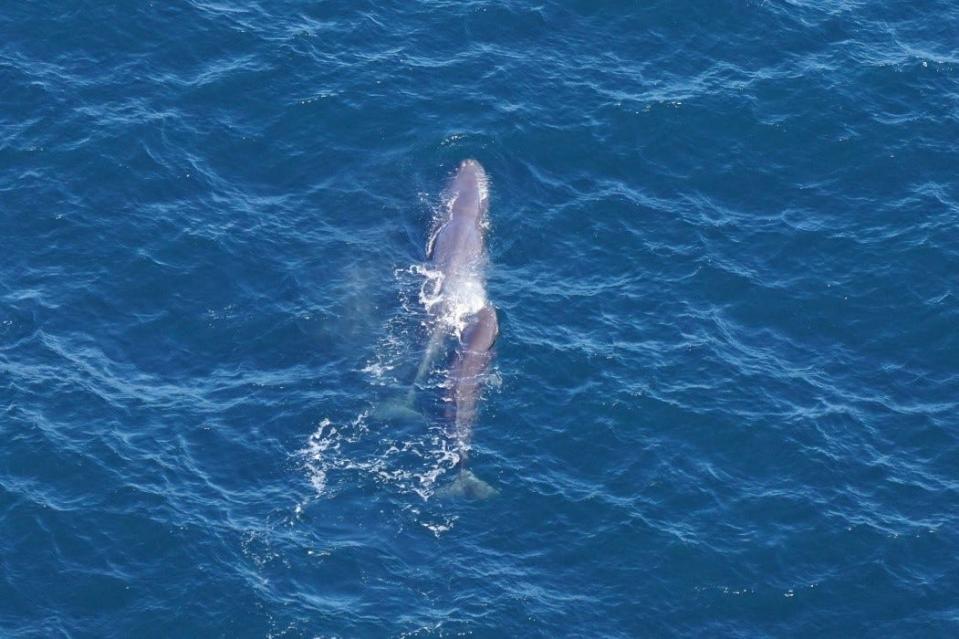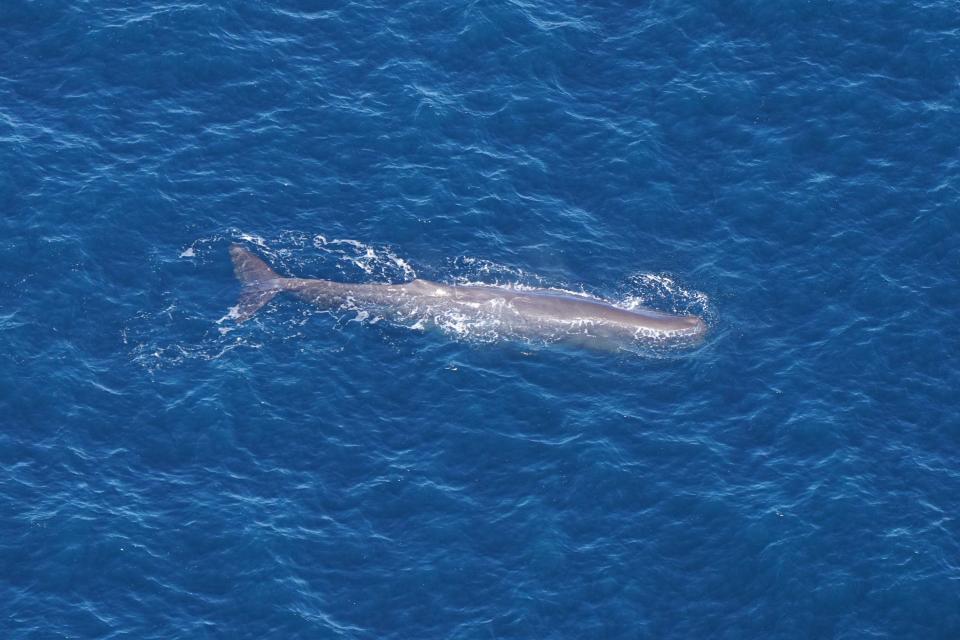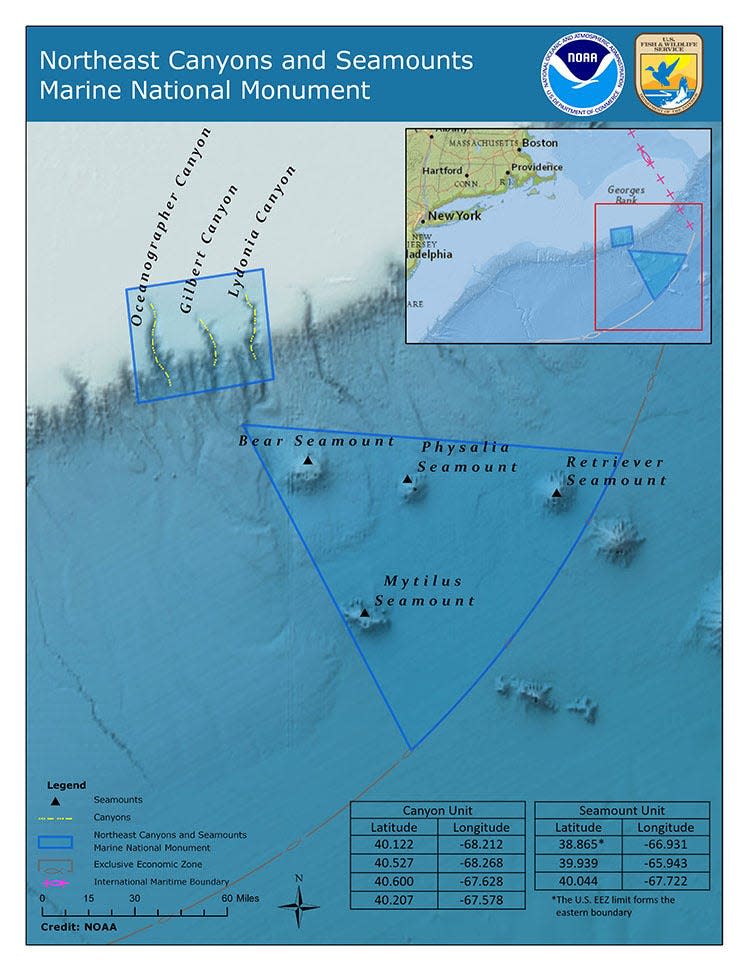'A lot of excitement.' Sperm whale calf seen southeast of Cape Cod in aerial survey
Waters north and south of Cape Cod have seen some unusual visitors this year, including five orcas in June and a lone manatee in September. Now there's another rarely-seen set of marine travelers to add to the list.
Scientists with the New England Aquarium are reporting a sighting of three sperm whales — the classic, large-headed whales familiar on weather vanes and all manner of coastal home decor, and the inspiration behind the literary whale made famous by 19th-century American novelist Herman Melville in "Moby Dick."

The whales, notably including an adult swimming with a calf, were spotted Oct. 19 as researchers were conducting a routine aerial survey over the Northeast Canyons and Seamounts Marine National Monument — an approximately 4,913-square-mile area about 130 miles east-southeast of Cape Cod.
It was particularly thrilling for the scientists to see the sperm whale calf, a first in six years of surveys over the area.
"It's the calf that was special," said Sharon Hsu, a research technician with the New England Aquarium Anderson Cabot Center for Ocean Life, because it was the first time spotting a baby in an area where the team has observed adult sperm whales "fairly consistently."
She said when the team spotted the adult that was with the calf, at first they didn't realize there were two individuals.
"We were flying along and we diverted because I spotted the large sperm whale," she said.
As they circled back, the photographer on the team started snapping images. "She said, 'I think there are two!'" Hsu said. "Then we realized it was a little one. There was a lot of excitement on the plane."
While she said no overreaching conclusions can be made about the presence of a calf, part of the excitement of seeing one is seeing evidence that babies are being born into the population.
It is not known if the adult the calf was seen with is its mother. That's because sperm whales are known for communal maternal-like interactions, "meaning that adults other than the mother may occasionally take care of calves, including nursing them," according to the aquarium.

"Sperm whales are known for this type of alloparental care, where someone else might step in while the mother is either foraging or on a deeper dive," Hsu said.
The second adult sperm whale the team observed was not with the pair, Hsu said, but was moving along a different track line of the survey route.
What is a sperm whale?
Sperm whales — listed as endangered under the Endangered Species Act and as depleted under the Marine Mammal Protection Act — are the largest of the toothed whales and the third largest cetacean species after blue whales and fin whales. Sperm whales were a primary target of the commercial whaling industry from 1800 to 1987, which nearly decimated all sperm whale populations, according to the National Oceanic and Atmospheric Administration's species directory.
"While whaling is no longer a major threat, sperm whale populations are still recovering," the agency notes.
The three sperm whales that the New England Aquarium scientists observed on Oct. 19 were among 324 marine animals they recorded during their five-hour survey flight. They also observed: 117 bottlenose dolphins, four fin whales, 27 Risso’s dolphins, two humpback whales, 15 ocean sunfish, 150 common dolphins, one True’s beaked whale, and four unidentified beaked whales.

What is the Northeast Canyons and Seamounts Marine National Monument?
The Northeast Canyons and Seamounts Marine National Monument is one of the nation's newer natural monuments and the only marine national preserve in the U.S. Atlantic Ocean. Described by the scientists as "a biodiversity hotspot," it includes three undersea canyons that are deeper than the Grand Canyon and four seamounts, or extinct volcanoes, that are taller than any mountain east of the Rocky Mountains.
President Obama designated the monument in 2016, and scientists were a big part of making that happen through science that demonstrated the diversity of the habitat and its importance as a place where marine animals — including many endangered and threatened species — feed and shelter. Additionally, according to the aquarium, "dozens of species of coral create deep-sea ecosystems" in the monument area.
Scientists from the aquarium have completed 16 aerial surveys of the area since the monument was created, and have remained continually amazed by its "remarkable marine mammal biodiversity."
As the U.S. Fish and Wildlife Service and NOAA draft a management plan for the monument, the aquarium researchers this week planned to submit a letter urging the agencies to "ensure sustainable sources of funding for public education and outreach about the Monument." The letter will also urge the agencies to monitor and manage activities in the Monument including shipping, recreational fishing, as well as to monitor the impacts of climate change and to "build upon existing scientific data with more comprehensive research to expand understanding of the area and inform effective management of its resources."
Heather McCarron writes about climate change, environment, energy, science and the natural world, in addition to news and features in Barnstable and Brewster. Reach her at hmccarron@capecodonline.com, or follow her on X @HMcCarron_CCT
Thanks to our subscribers, who help make this coverage possible. If you are not a subscriber, please consider supporting quality local journalism with a Cape Cod Times subscription. Here are our subscription plans.
This article originally appeared on Cape Cod Times: Sperm whales seen off Cape Cod, Islands in aerial research survey

